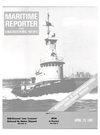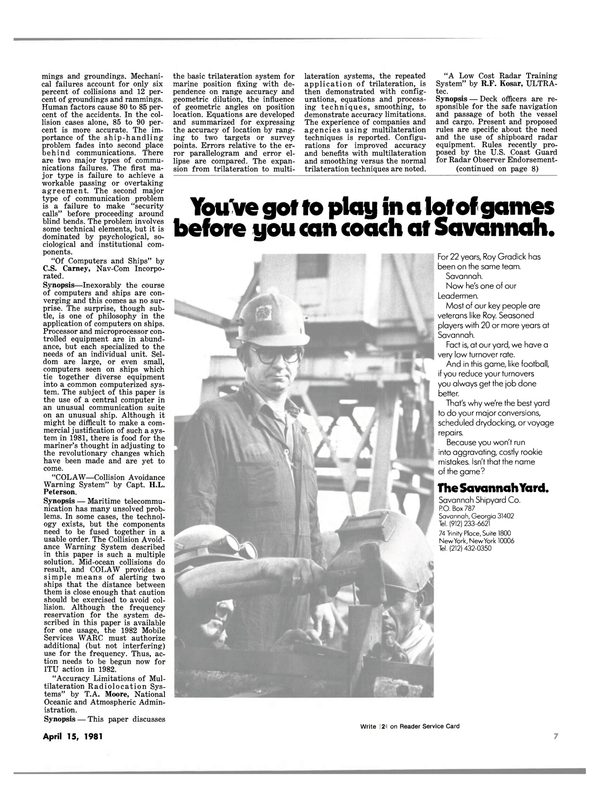
Improved Controllability Topic At Chesapeake Section Meeting
Members of the Chesapeake Section of The Society of Naval Architects and Marine Engineers met recently to hear the presentation of a paper titled "Evaluation of Concepts for Improved Controllability of Tank Vessels," by Eugene Miller, Vladimir Ankudinov, and Thomas Ternes.
Both Mr. Miller and Dr. Ankudinov are with Hydronautics, Inc.
of Laurel, Md., while Mr. Ternes is now with Morris Guralnick Associates of San Francisco, although at the time the work presented in the paper was accomplished he was also working for Hydronautics.
The paper was presented by Mr. Miller and Mr. Ternes, and is based on a study done by the authors for the Maritime Administration in which the reasons for tanker casualties involving collision, ramming and grounding, and concepts for improving controllability were evaluated. The U.S. Coast Guard casualty data bank was used as the source of information for the casualty analysis.
The data for a five-year period (1971-1976) were reviewed, and cases where controllability played a major role were evaluated.
Only casualties occurring in U.S. waters or involving U.S. vessels in foreign waters were contained in the Coast Guard's data bank; therefore, the study was limited to those cases.
Based on this review, it was determined that the major cause of tanker casualties involving collision, ramming, or grounding result from human error, followed by control problems in wind and current, inability to turn sharply enough, insufficient tug assistance, stopping, bank suction/ sheer, steering / propulsion failure, control while slowing, and control while backing in that general order. Human error caused casualties were not considered further although it was acknowledged that, in many cases, improved vessel controllability could have mitigated the consequences of the human error. The types of controllability required to reduce the number and severity of these casualties were evaluated and categorized into such areas as the ability to maintain control of the vessel after losing one steering or propulsion unit, the ability to maintain steerageway while slowing down, and the ability to control heading while backing. Finally, the costs incurred as a result of the casualties were investigated to form a basis for the determination of the cost effectiveness of concepts for improving tanker controllability.
The second phase of the study involved the evaluation of various methods of increasing controllability through the use of a computer simulation of ships' maneuvering characteristics and a series of model tests. A singlescrew, single-rudder, 84,000-deadweight- ton tanker with a steam propulsion plant of approximately 18,000 shp was selected as the baseline ship against which improvements in c o n t r o l l a b i l i ty would be measured. Five concepts for improved controllability were evaluated, i.e., twin propellers and rudders, increased astern power, maneuvering propulsion devices (tunnel thrusters, active rudder), high lift rudders (flapped rudders r o t a t i n g c y l i n d e r rudder), and thrust vectoring devices including steering Kort nozzle and Kitchen rudder. The Kitchen rudder is a movable shroud that surrounds the propeller and is roughly analogous to the thrust reversers found on airliners.
The authors concluded that the use of the leading concepts investigated can be attractive from a shipowner's point of view. The moderator, Comdr. James Card of the U.S. Coast Guard, supported this conclusion and referred to the fact that improving vessel safety through approaches that offer financial advantages to owners is preferable to achieving the same goals through regulation.
Read Improved Controllability Topic At Chesapeake Section Meeting in Pdf, Flash or Html5 edition of April 15, 1981 Maritime Reporter
Other stories from April 15, 1981 issue
Content
- United States Cruises Acquires Title To SS 'United States' page: 4
- Improved Controllability Topic At Chesapeake Section Meeting page: 5
- 1981 RTCM ASSEMBLY page: 6
- ASNE Day 1981 Scheduled For April 30-May 1 In Washington page: 8
- Long Beach Terminal Orders Two Additional Transtainer Cranes page: 9
- Gulf Fleet Marine Will Add 19 New Vessels At Total Cost Of $50 Million page: 11
- Twin EMD Diesels Power Newest Turecamo Tug Built By Matton page: 12
- New Cruise Line Features Yacht-Like Luxury Ships page: 12
- Levingston Launches Jackup Drilling Rig For Dixilyn-Field page: 14
- Hampton Roads SNAME Hears Paper On Shipboard Piping page: 14
- Halter Delivers Tug/Supply Boat To D.F. Levy Marine page: 15
- Ship Structure Committee Offers Three Free Technical Reports page: 16
- New Drydock Doubles Capacity At Newport News Shipbuilding page: 16
- Fuel Utilization Seminar And Exposition Scheduled For Baltimore Sept. 1-4 page: 17
- Enclosed Lifeboats Serve As Escape Craft For Offshore Oil Platforms page: 17
- IHI Delivers Suction Dredge And Tug To Mexican Government page: 18
- Los Angeles SNAME Discusses Liquid Level Gauging By Radar page: 18
- American President Lines To Test Feasibility Of 45-Foot Cargo Containers page: 19
- New Supply/Fire-Fighting Vessel Delivered To Gulf Fleet Marine page: 20
- NAVIGATION & COMMUNICATIONS EQUIPMENT A Review page: 22
- GM-Powered Towboat 'Trotter' Delivered By Hudson Shipbuilders page: 46
- Marinette Launches Another Berthing Barge For U.S. Navy page: 46
- Mare Island Naval Shipyard Elects New NCAA Officers page: 46
- Hellenic Lines To Convert Four Cargo Ships To Container Vessels page: 48
- Standard 35,000-dwt Bulk Carrier Developed By Japan's Nippon Kokan page: 48
- Choctaw Asks Title XI For Rig Reconstruction To Cost $86 Million page: 48
- VPA Draws Plans For 25-Million-Ton Coal Exporting Facility page: 51
- ASNE Delaware Valley Chapter Hears Report On Delaware River page: 51
- Holland-America Selects Sulzer Diesel Engines For Its Two Cruise Ships page: 51
- Promet Private Launches Jackup Drilling Rig For Sedco page: 52
- SNAME New York Section Honors William J. Dormari page: 52
- Marathon LeTourneau, C-E And Sea Tank Form New Company page: 53
- Broughton Rig Commissioned At Bethlehem's Beaumont Yard page: 54
- Mangone Swiftships Delivers Pocket Tanker To Sun Transport page: 54
- Long Beach-Los Angeles ASNE Elects New Officers page: 54
- New Catalog Describes Coppus Engineering's Turbine Generator Sets page: 55
- Big Car Carrier 'Glorious Ace' Completed By Hitachi Zosen page: 56
- HUDSHIP Delivers Twin Supply Vessels To Gray Mackenzie page: 56
- Lykes President W.J. Amoss Receives American Legion Merchant Marine Award page: 70
- IME Eastern U.S.A. Branch Hears Paper On Fuel Treatment page: 70


